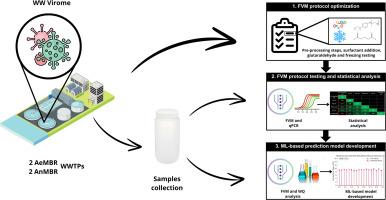当前位置:
X-MOL 学术
›
Water Res.
›
论文详情
Our official English website, www.x-mol.net, welcomes your
feedback! (Note: you will need to create a separate account there.)
Combining flow virometry with tree-based machine learning models for rapid virus particle estimation in different wastewater matrices
Water Research ( IF 11.4 ) Pub Date : 2025-05-29 , DOI: 10.1016/j.watres.2025.123905
Yevhen Myshkevych, Ibrahima N'Doye, Julie Sanchez Medina, Fahad K. Aljehani, Yanghui Xiong, Taous-Meriem Laleg-Kirati, Pei-Ying Hong
Water Research ( IF 11.4 ) Pub Date : 2025-05-29 , DOI: 10.1016/j.watres.2025.123905
Yevhen Myshkevych, Ibrahima N'Doye, Julie Sanchez Medina, Fahad K. Aljehani, Yanghui Xiong, Taous-Meriem Laleg-Kirati, Pei-Ying Hong

|
Enumerating virus particles (VPs) at different stages of the wastewater treatment process or along the distribution network is essential for ensuring high performance and reducing public health risks. Herein, we aimed to (i) optimize the flow virometry (FVM) protocol for use in wastewater matrices, (ii) correlate FVM data with specific virus genera of interest, and (iii) develop machine learning (ML) models for determining total VP concentration. We identified and tested a comprehensive set of parameters to determine the optimal conditions for wastewater FVM. Specifically, we tested various sample preprocessing steps to enhance FVM detection sensitivity, including the use of different nucleic acid staining dyes, surfactant addition and concentration optimization, glutaraldehyde fixation, and the effect of sample freezing before FVM analysis. Spearman's rank correlation of FVM data with virus genera concentration using a conventional qPCR-based method in 206 samples showed a positive correlation for all five virus genera, ranging from 0.21 to 0.44 (p < 0.01). The extreme gradient-boosting (XGB) model using easily accessible physiochemical water parameters (such as turbidity, electroconductivity, total dissolved solids, total suspended solids, pH, chemical oxygen demand, and concentrations of nitrate nitrogen, nitrite nitrogen, and ammonium nitrogen) as input data outperformed the random forest (RF) model and can be used to estimate total virus count across all types of wastewater matrices as output data. Furthermore, XGB achieved a better root mean square error in the four treatment processes (influent, aerobic, sand, and MBR) by a mean of 23% than RF in model development. This study demonstrates that FVM, combined with ML, can significantly enhance monitoring capabilities by accurately estimating VP concentrations across diverse wastewater matrices.
中文翻译:

将流式病毒测量与基于树的机器学习模型相结合,在不同废水基质中快速估计病毒颗粒
在废水处理过程的不同阶段或沿分配网络计数病毒颗粒 (VP) 对于确保高性能和降低公共卫生风险至关重要。在此,我们的目标是 (i) 优化用于废水基质的流式病毒测定 (FVM) 方案,(ii) 将 FVM 数据与感兴趣的特定病毒属相关联,以及 (iii) 开发用于确定总 VP 浓度的机器学习 (ML) 模型。我们确定并测试了一组全面的参数,以确定废水 FVM 的最佳条件。具体来说,我们测试了各种样品预处理步骤以提高 FVM 检测灵敏度,包括使用不同的核酸染色染料、表面活性剂添加和浓度优化、戊二醛固定以及 FVM 分析前样品冷冻的效果。在 206 个样本中使用基于常规 qPCR 的方法对 FVM 数据与病毒属浓度进行 Spearman 秩相关,显示所有五个病毒属均呈正相关,范围为 0.21 至 0.44 (p < 0.01)。极端梯度提升 (XGB) 模型使用易于获取的理化水参数(例如浊度、电导率、总溶解固体、总悬浮固体、pH 值、化学需氧量以及硝酸盐氮、亚硝酸盐氮和铵态氮的浓度)作为输入数据,其性能优于随机森林 (RF) 模型,可用于估计所有类型废水基质中的病毒总数作为输出数据。此外,XGB 在四个处理过程 (进水、好氧、砂和 MBR) 中实现了更好的均方根误差,在模型开发中平均比 RF 高 23%。 本研究表明,FVM 与 ML 相结合,可以通过准确估计不同废水基质中的 VP 浓度来显著提高监测能力。
更新日期:2025-05-29
中文翻译:

将流式病毒测量与基于树的机器学习模型相结合,在不同废水基质中快速估计病毒颗粒
在废水处理过程的不同阶段或沿分配网络计数病毒颗粒 (VP) 对于确保高性能和降低公共卫生风险至关重要。在此,我们的目标是 (i) 优化用于废水基质的流式病毒测定 (FVM) 方案,(ii) 将 FVM 数据与感兴趣的特定病毒属相关联,以及 (iii) 开发用于确定总 VP 浓度的机器学习 (ML) 模型。我们确定并测试了一组全面的参数,以确定废水 FVM 的最佳条件。具体来说,我们测试了各种样品预处理步骤以提高 FVM 检测灵敏度,包括使用不同的核酸染色染料、表面活性剂添加和浓度优化、戊二醛固定以及 FVM 分析前样品冷冻的效果。在 206 个样本中使用基于常规 qPCR 的方法对 FVM 数据与病毒属浓度进行 Spearman 秩相关,显示所有五个病毒属均呈正相关,范围为 0.21 至 0.44 (p < 0.01)。极端梯度提升 (XGB) 模型使用易于获取的理化水参数(例如浊度、电导率、总溶解固体、总悬浮固体、pH 值、化学需氧量以及硝酸盐氮、亚硝酸盐氮和铵态氮的浓度)作为输入数据,其性能优于随机森林 (RF) 模型,可用于估计所有类型废水基质中的病毒总数作为输出数据。此外,XGB 在四个处理过程 (进水、好氧、砂和 MBR) 中实现了更好的均方根误差,在模型开发中平均比 RF 高 23%。 本研究表明,FVM 与 ML 相结合,可以通过准确估计不同废水基质中的 VP 浓度来显著提高监测能力。


















































 京公网安备 11010802027423号
京公网安备 11010802027423号